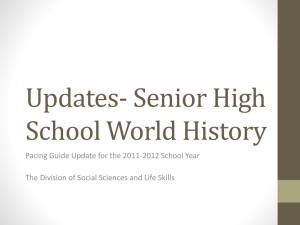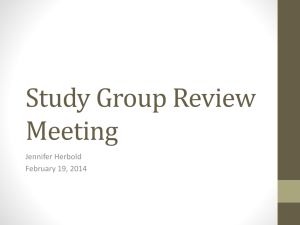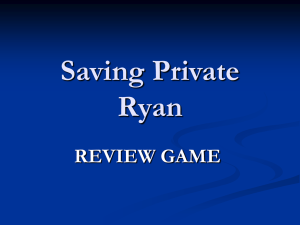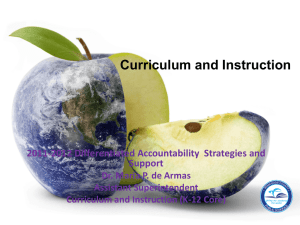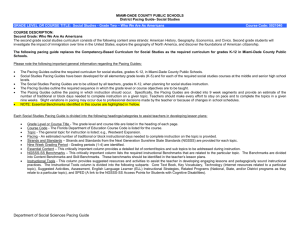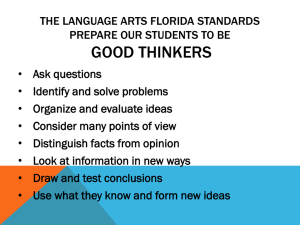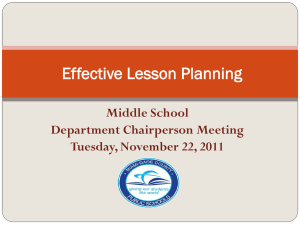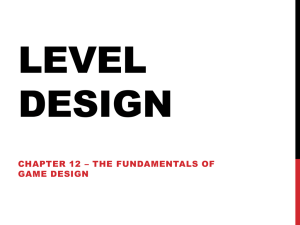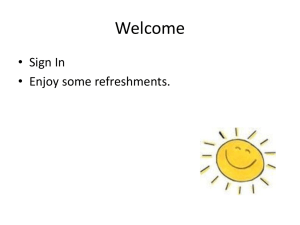Lane: 3 – Analytic Writing
advertisement
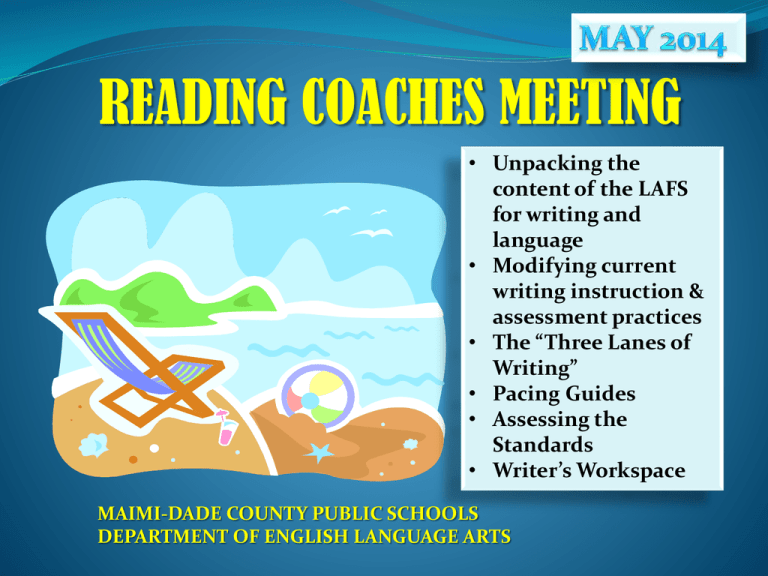
READING COACHES MEETING • Unpacking the content of the LAFS for writing and language • Modifying current writing instruction & assessment practices • The “Three Lanes of Writing” • Pacing Guides • Assessing the Standards • Writer’s Workspace MAIMI-DADE COUNTY PUBLIC SCHOOLS DEPARTMENT OF ENGLISH LANGUAGE ARTS CREATE A “TO DO” LIST…. THE IMPORTANCE OF WRITING • Students who do not learn how to write well are at a disadvantage • Weaker writers are less likely to: use writing to extend their learning Less likely to attend college and complete a college degree • Growing trend to use writing proficiency as one factor in graduation eligibility and grade retention decisions or advancement CURRENT STUDENT WRITING PERFORMANCE AND INSTRUCTION • Presents overall weak writing instruction • Only thirty minutes set aside for writing instruction • The thirty minutes is usually spent on decontextualized basic writing skills • More institutes of higher learning are creating noncredit courses to remediate the writing problems of college students THE MOVE TO COMMON CORE STATE STANDARDS FOR WRITING AND LANGUAGE • Evidence shows that well developed content standards have a significant impact on student achievement through their influence on classroom instruction • Content standards are designed, ideally, to inform curriculum development, guide instruction and assessment, provide clear goals for student achievement, and raise performance expectations • Although high-stakes assessments may guarantee that what is assessed is taught, they do not guarantee quality classroom instruction or necessarily promote effective teaching and can come with unintended consequences EVALUATION OF THE CCSS-WL • Evaluated for breadth of content coverage • Using the seven strands derived from several frameworks • The model used was Hayes’ Cognitive Model of Writing Writing Process Metacognition and Knowledge Context Strand (genre theory) Purpose Components Conventions Motivation • Standards do not specify the “how” of instruction but rather the “what” • Attainment of the standards via instructional practices focused on the writing process • Supplement when necessary YOUR TURN…. RESULTS OF EVALUATION: UNPACKING THE CCSS-WL AND HOW TO BEST IMPLEMENT IT GROUP 1 – WRITING PROCESS GROUP 2 – WRITING CONTEXT GROUP 3 – WRITING PURPOSE GROUP 4 – WRITING COMPONENTS ADD GROUP 5 – WRITING CONVENTIONS SHARING GROUP 6 – WRITING KNOWLEDGE/METACOGNITON GROUP 7 – WRITING MOTIVATION THE ARTICLE GROUP 8 – IMPLEMENTING CCSS-WL WITH INNOVATIVE WITH TECHNOLOGY TEACHERS MAJOR POINTS INSTRUCTIONAL IMPLICATIONS BE READY TO SHARE! K-5 • Highlighting = Amended Standard by the state • Underlying within the highlighting= specific change in wording • Italics= Increase in expectation within the standard from grade level to grade level ADD DISTRIBUTE AND EXPLAIN LAFS Think of the writing in McGrawHill like a 3 lane highway… Lane: 1 – Traits (Skills) Lane: 2 – Genre Writing (Apply Traits) Lane: 3 – Analytic Writing (Apply Traits & Genre to what you Read) ADD EXPLAIN AND PLAN FOR THE 3 LANES OF WRITING Lane #1 The way we present our message on paper, the overall appearance: making it inviting both visual and textual elements Balancing white space visuals text graphics Neatness typed text or cursive handwriting font selection borders Lane #2 Characteristics of Genres-Grades K & 1 Opinion/Argument LAFS.K-1.W.1.1 Kindergarten Draws a picture, dictates or writes to: Tell the topic or title States opinion or preference Informational/Explanatory Narrative LAFS.K-1.W.1.3 LAFS.K-1.W.1.2 Kindergarten Draws a picture, dictates or writes to Names the topic Supplies some information about the topic Facts, details, description Kindergarten Draws a picture, dictates or writes to Tells about a single event or several loosely linked events in the order in which they occurred • Establishes the situation by naming a place Provide a reaction to what happened Grade 1 Introduces the topic or title Topic sentence States an opinion Supplies a reason for the opinion Provides some sense of closure Ending sentence Grade 1 Names the topic Supplies some facts about the topic Includes ideas that explain and support Provides some sense of closure Ending sentence Grade 1 Recounts two or more appropriately sequenced events Beginning-of-sentence capitalization and end- of- sentence punctuation Establishes the situation with the opening sentence Includes details about what happened Feelings and reaction Uses temporal words to signal event order Provides some sense of closure Growing Command of Conventions Reflective endings Ending sentence Capital letters for proper nouns Capitalize text title Characteristics of Genres-Grade 2 Opinion/Argument Introduces the topic or text Introductory paragraph Beginnings States an opinion Supplies reasons that support the opinion Clump Details Includes people who are on your side Tells what you will do if you get it (If…then…) Tells why you should have it NOW Uses feelings Uses linking words Provides a conclusion Informational/Explanatory Narrative Introduces the topic Uses facts and definitions to develop points Recounts a wellelaborated event or short sequence of events Includes details to describe actions, thoughts, and feelings Descriptive attributescolor, #, size, age, shape May include comparing facts Includes domain specific vocabulary Provides a concluding statement or section Techniques for closure (Endings) Strong verbs Sensory details Descriptive attributescolor, #, size, age, shape Specificity-uses names for people and pets Uses temporal words to signal event order Provides a sense of closure Techniques for closure (Endings) Growing Command of Conventions Capital letters in title, pronoun I, and the beginning of a sentence Title of book is underlined Most words are spelled correctly Commas and apostrophes used correctly End punctuation Opinion/Argument LAFS.3-5.W.1.1 Informational/Explanatory LAFS.3-5.W.1.2 Examines a topic and conveys ideas and States an opinion or point of information clearly according view to audience and purpose Includes an organizational structure that lists reasons that Introduces topic and groups related ideas together and support/prove the opinion presented in order of Descriptive details importance (include illustrations Concrete proof Introduces the topic or text Includes others who have the when aiding comprehension) Develops the topic with facts, definitions, details, examples, quotations and comparisons Includes precise language and domain specific vocabulary Uses linking words and Uses linking words and phrases phrases to connect ideas that connect opinion and within categories of reasons information May include an opposing Provides a concluding viewpoint statement or section Provides a conclusion statement or section same opinion(quote) Tells what will/might happen if(If…then…) Includes comparisons a mini-story that supports the topic Narrative LAFS.3-5.W.1.3 Tells a real or imagined experiences or events Needs to include the elements of a story establishes a situation and introduce a narrator and/or characters, setting, organized event sequence- that unfolds naturally Moves through time with temporal words/phrases for event order Dialogue Descriptions of actions, thoughts and feelings to develop experiences, events or reactions of characters Uses sensory details Provide a sense of closure Lane #1: Traits Lane #2: Genre 30 Minutes Language Arts Block!!!!! Process Writing Kindergarten-2nd Grade McGraw-Hill Green Pages Trait Genre: Apply Trait!!!!! Day 1: Shared Writing Day 2: Interactive Writing Days 3-5 Independent Writing Grades 3-5 Trait Genre: Apply Trait!!!! Genre Writing 2-5 Apply the Trait!!!!! Lane #3 Students will examine the author’s ideas, apply the writing traits and the characteristics of the genre to perform the task!!!!!!!!! Write About Reading/Analytical Writing Kindergarten First Grade Write About Reading/Analytical Writing 2-5 PACING GUIDES…. WHAT’S NEW?? More scripting in Start Smart LAFS Analytic Writing – Constructed Response Items (Gr. 2-5) Handwriting Suggested District Instructional Tools Lesson Pacing START SMART Pacing Guide for… Writing START SMART (Writing) K/1 Pacing Guide… START SMART (Writing) Pacing Guide 2nd Grade START SMART (Writing) Pacing Guide Grades 3-5… START SMART Pacing Guide for… Reading START SMART (Reading) Pacing Guide K/1st … START SMART (Reading) Pacing Guide Grade 2-5 REGULAR Pacing Guide Writing Kindergarten/First Grade Writing Pacing Guide 2nd Grade Writing Pacing Guide 3rd-5th Grade Writing Pacing Guide REGULAR Pacing Guide Reading Kindergarten/First Grade Reading Pacing Guide 2nd Grade Reading Pacing Guide 3rd - 5th Grade Reading Pacing Guide ADD Share with teachers “What’s New” about Pacing Guides Handwriting… Found in the Reading & Writing Pacing Guides New Handwriting LAFS in Grades 2-5 Where are the “Handwriting” LAFS Handwriting in the Pacing Guides Available Handwriting Resources…. K-1 Manuscript Writing Connected to “Word Work” Grades 3-5 Cursive Writing 2nd Gr. Transition from Manuscript to Cursive Writing The American Institutes for Research (AIR) will develop, administer, score and report assessments that are aligned to Florida’s standards in English language arts/literacy in 2014-15 On March 17, 2014, an announcement was made on the selection of the American Institutes for Research (AIR) to develop, administer, score and report assessments that are aligned to Florida’s standards in English language arts/literacy in 2014-15. This table describes resources and related information, as well as the current timeline for the release of each resource. Sample test questions and the test item specifications, identified as “DRAFT,” will be released as preliminary documents and will be expanded and updated at a later date following the initial release. POSSIBILITIES!! Let’s take a look at the type of test items the students may encounter on the LAFS end-of-year assessment. Scores will provide teachers with progress monitoring data to guide instruction. Scores are not intended to be used for classroom grading purposes. Let’s Take a Closer Look! WHAT DID YOU NOTICE?? INFORMATIONAL NARRATIVE OPINION STEMS/KEY WORDS INSTRUCTIONAL IMPLICATIONS CONNECTIONS (LAFS; RDG; WTG) AHA’S Carousel Our Observations! ADD Share with teachers possible test items & instructional implications Implementing the LAFS-WL with Innovative Technology • Educational technology has exploded and offers a wealth of support to educators as they realign writing instruction to better address the content of the LAFS-WL and reimagine how they might implement those best practices... …can be used to facilitate many aspects of the writing process, including organization, planning, prewriting, and drafting. The Reading Teacher Vol. 67 Issue 6 pp. 445–453 ©2014. The Neglected R in a Time of Common Core. International Reading Association WRITER’S WORKSPACE LESSON INSTRUCTIONS GUIDED AND INTERACTIVE MODEL GUIDED WRITING PROCESS WITHIN A WORD PROCESSING PROGRAM ACCESS THROUGH THE TEACHER PORTAL/DASHBOARD ADD Demo the “Writer’s Workspace” Things To Do: • Share article with teachers • Distribute/Explain and Discuss LAFS • Share with teachers “What’s New” about Pacing Guides • Discuss/Explain Rdg/Wtg connection in the Pacing Guides • Explain/Plan for the 3 Lanes of Writing with Pacing Guides • Share with teachers type of test items the students may encounter on the LAFS end-ofyear assessment/Instructional implications • Pull materials for “Start Smart” (PDF’s, G.O.) • Demo the “Writer’s Workspace” for teachers • Relax and Reboot…..
